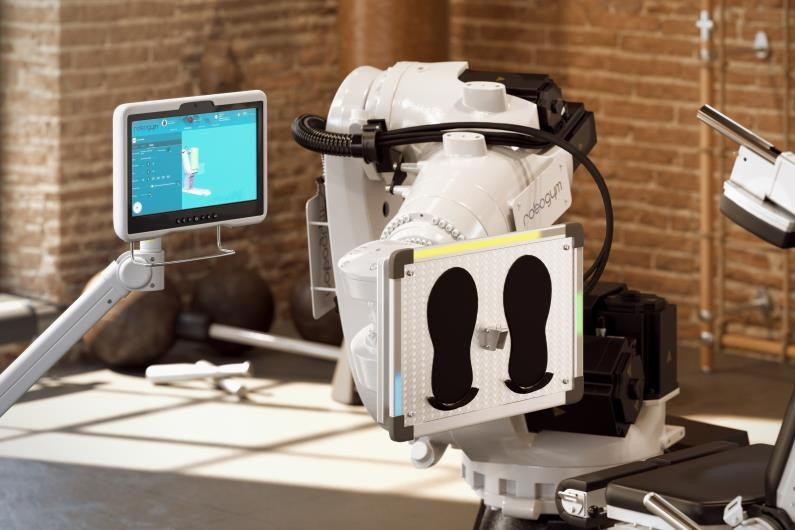• Iterative Learning Control of an Industrial Robot for Neuromuscular Training; Ketelhut, M., Göll,
F., Braunstein, B., Albracht, K. & Dirk, A., 01.08.2019, CCTA 2019 - 3rd IEEE Conference on Control
Technology and Applications: IEEE CCTA 2019, August 19-21, 2019, City University of Hong Kong,
Hong Kong, China. S. 926-932 7 S. (CCTA 2019 - 3rd IEEE Conference on Control Technology and Applications).
• Admittance Control of an Industrial Robot during Resistance Training, Ketelhut; M., Kolditz, M.,Göll, F., Braunstein, B., Albracht, K. & Abel, D., 2019, in : IFAC-PapersOnLine. 52, 19, S. 223-2286 S.
• Auf muskuloskelettalen Modellen basiertes Biofeedback für individualisiertes neuro-muskuläres
Training und Rehabilitation; Göll, F., Braunstein, B., Ketelhut, M., Abel, D. & Albracht, K., 2019, (In
Vorbereitung) 4. Forschungssymposium Physiotherapie: 22. und 23. November 2019; empirische
Forschung und Theorieentwicklung verbinden ; Abstractband. Deutsche Gesellschaft für
Physiotherapiewissenschaft (DGPTW), S. 32-33 2 S.
• Admittance Control of an Industrial Robot during Resistance Training; Maike Ketelhut, Melanie
Kolditz, Fabian Göll, Bjoern Braunstein, Kirsten Albracht, Dirk Abel, Admittance Control of an
Industrial Robot during Resistance Training, IFAC-PapersOnLine, Volume 52, Issue 19, 2019, Pages 223-228, ISSN 2405-8963, https://doi.org/10.1016/j.ifacol.2019.12.102.
• Biofeedback for individualized neuromuscular training and rehabilitation based on musculoskeletal
models; Göll, F., Braunstein, B., Maike, K., Abel, D. & Albracht, K., 24.09.2018, in : Biomedizinische
Technik. Biomedical engineering. 63, S1, S. S15 1 S.
• Comparison of Different Training Algorithms for the Leg Extension Training with an Industrial Robot: Current Directions in Biomedical Engineering; Ketelhut, M., Göll, F., Braunstein, B., Albracht, K. & Abel, D., 24.09.2018, in : Current Directions in Biomedical Engineering. 4, 1, S. 17-20 4 S.
• Evaluation of foot position and orientation as manipulated variables to control external knee
adduction moments in leg extension training; Kolditz, M., Albin, T., Abel, D., Fasse, A.,Brüggemann,
G. P., & Albracht, K. (2019). Computer Methods and Programs in Biomedicine, 171, 81–86.
https://doi.org/10.1016/j.cmpb.2016.09.005
• Isokinematic leg extension training with an industrial robot; Kolditz, M., Albin, T., Albracht, K.,
Bruggemann, G. P., & Abel, D. (2016). In Proceedings of the IEEE RAS and EMBS International
Conference on Biomedical Robotics and Biomechatronics (Vol. 2016-July, pp. 950–955). IEEE
Computer Society. https://doi.org/10.1109/BIOROB.2016.7523750
• Robotic system to improve neuromuscular strength training of the leg extensors; Kolditz, M., Albin,
T., Brüggemann, G. P., Abel, D., & Albracht, K. (2016). At-Automatisierungstechnik, 64(11), 905–914.
https://doi.org/10.1515/auto-2016-0044
• Simulative analysis of joint loading during leg press exercise for control applications; Kolditz, M.,
Albin, T., Abel, D., Fasse, A., Brüggemann, G. P., & Albracht, K. (2015). In IFAC-PapersOnLine (Vol. 28, pp. 435–440). https://doi.org/10.1016/j.ifacol.2015.10.179



